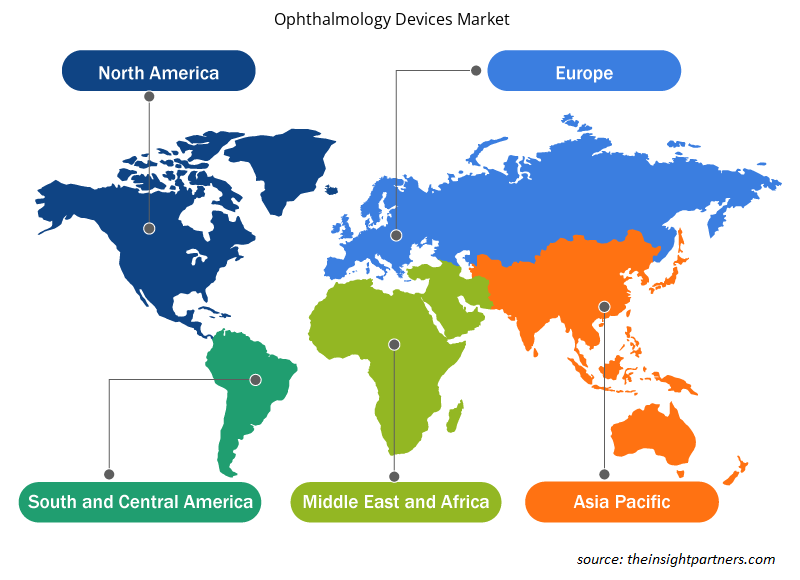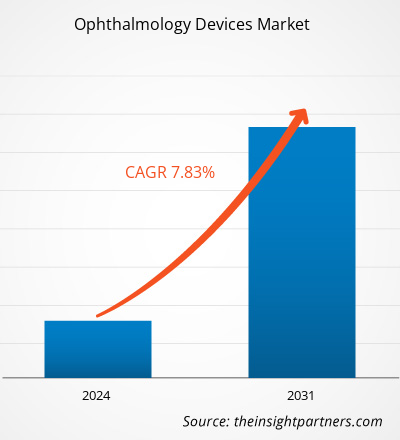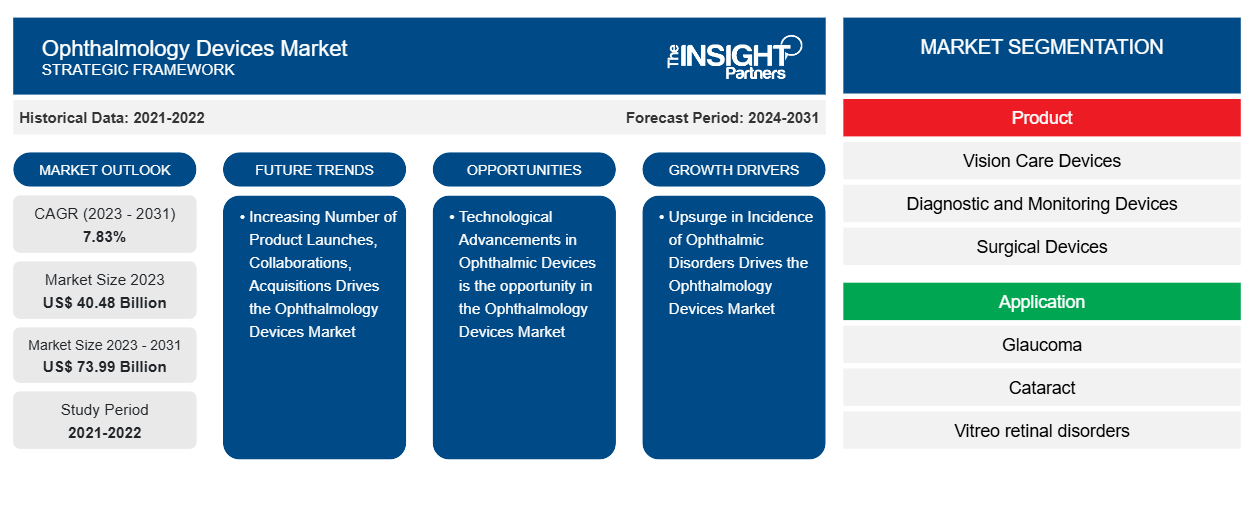眼科设备市场规模预计将从 2023 年的 404.8 亿美元增至 2031 年的 739.9 亿美元。预计 2023-2031 年市场复合年增长率将达到 7.83%。眼科疾病患病率的上升可能仍是眼科设备市场的主要趋势。
眼科设备市场分析
眼科设备用于手术、诊断和视力矫正。由于白内障、青光眼和其他视力相关问题的发病率很高,这些设备多年来变得越来越重要。此外,眼科设备市场的公司正在推出技术先进的隐形眼镜和眼镜片。由于医疗技术的进步、生活方式改变导致的眼部疾病患病率上升、慢性病发病率上升以及人口老龄化加剧,对眼科诊断和监测设备的需求正在上升。人工智能 (AI)、远程医疗和物联网 (IoT) 等先进技术在眼科筛查程序中发挥着关键作用,从而提高了运营效率、准确性、成本效益和眼科护理的可及性。
眼科设备市场概况
技术创新一直是任何生命科学学科的基础,包括眼科,因为现代设备是准确诊断和改善治疗的关键。药物、诊断设备、激光系统和手术技术的进步使得青光眼、白内障和黄斑变性以及干眼症的诊断得到改善。眼科疾病发病率的上升以及产品发布、收购和合作数量的增加等因素正在推动市场增长。此外,眼科设备的技术进步也为市场带来了机遇。然而,眼科手术的高成本是阻碍市场增长的主要因素。
定制此报告以满足您的需求
您可以免费定制任何报告,包括本报告的部分内容、国家级分析、Excel 数据包,以及为初创企业和大学提供优惠和折扣
-
获取此报告的关键市场趋势。这个免费样品将包括数据分析,从市场趋势到估计和预测。
眼科设备市场驱动因素和机遇
眼科设备的进步有利于市场增长
虚拟现实、3D 成像以及大数据和人工智能 (AI) 正用于眼科的数据分析。这些工具使得获得准确可靠的结果成为可能。AI 等工具正用于糖尿病视网膜病变的筛查、病变检测和疾病进展监测(例如,年龄相关性黄斑变性或黄斑水肿的进展)。然而,这些工具仍在开发中,因为正在评估它们在眼部病变诊断和预后应用中的适用性。微创手术,如 LASIK(即激光辅助原位角膜磨镶术)手术、飞秒激光手术、多波长糖尿病视网膜病变治疗和超声乳化术,可能会增加对眼科设备的需求,进而推动整个市场的增长。
远程医疗日益受到关注,为市场带来机遇
技术创新始终是任何生命科学学科的基础,包括眼科,因为现代设备是准确诊断和改善治疗的关键。药物、诊断设备、激光系统和手术技术的进步使得青光眼、白内障和黄斑变性以及干眼症的诊断得到改善。虚拟现实、3D 成像、大数据和人工智能 (AI) 正用于眼科的数据分析。这些工具使我们获得准确可靠的结果成为可能。人工智能等工具正用于筛查糖尿病视网膜病变、检测病变以及监测某些疾病(如老年性黄斑变性或黄斑水肿)的进展。然而,这些工具仍在开发中,目前正在评估它们在眼部病变诊断和预后应用中的适用性。微创手术,例如 LASIK(即激光原位角膜磨镶术)手术、飞秒激光手术、多波长糖尿病视网膜病变治疗和超声乳化白内障吸除术可能会增加对眼科设备的需求,进而推动整个市场的增长。
眼科设备市场报告细分分析
有助于得出眼科设备市场分析的关键部分是产品、视力保健设备、诊断和监测设备、手术设备、应用和最终用户。
- 根据产品,眼科设备市场分为视力保健设备、手术设备以及诊断和监测设备。视力保健设备部分在 2023 年占据了最大的市场份额。
- 根据应用,市场细分为青光眼、白内障、玻璃体视网膜疾病、难治性疾病等。青光眼领域在 2023 年占据了主要市场份额。
- 就最终用户而言,市场细分为医院和眼科诊所、学术和研究实验室等。2023 年,医院和眼科诊所占据了市场主导地位。
眼科设备市场份额按地区分析
眼科设备市场报告的地理范围主要分为五个区域:北美、亚太、欧洲、中东和非洲以及南美和中美。北美地区的市场增长可归因于青光眼和白内障等眼部疾病的患病率上升,以及北美国家主要制造商的存在。
眼科设备市场区域洞察
Insight Partners 的分析师已详尽解释了预测期内影响眼科设备市场的区域趋势和因素。本节还讨论了北美、欧洲、亚太地区、中东和非洲以及南美和中美洲的眼科设备市场细分和地理位置。

- 获取眼科设备市场的区域特定数据
眼科设备市场报告范围
| 报告属性 | 细节 |
|---|---|
| 2023 年的市场规模 | 404.8亿美元 |
| 2031 年市场规模 | 739.9 亿美元 |
| 全球复合年增长率(2023 - 2031) | 7.83% |
| 史料 | 2021-2022 |
| 预测期 | 2024-2031 |
| 涵盖的领域 |
按产品
|
| 覆盖地区和国家 |
北美
|
| 市场领导者和主要公司简介 |
|
市场参与者密度:了解其对商业动态的影响
眼科设备市场正在快速增长,这得益于终端用户需求的不断增长,而这些需求又源于消费者偏好的不断变化、技术进步以及对产品优势的认识不断提高等因素。随着需求的增加,企业正在扩大其产品范围,进行创新以满足消费者的需求,并利用新兴趋势,从而进一步推动市场增长。
市场参与者密度是指在特定市场或行业内运营的企业或公司的分布情况。它表明在给定市场空间中,相对于其规模或总市场价值,有多少竞争对手(市场参与者)存在。
在眼科设备市场运营的主要公司有:
- 强生视力保健公司
- 爱尔康公司
- 卡尔蔡司医疗技术公司
- 博士伦公司
- 依视路国际公司
免责声明:上面列出的公司没有按照任何特定顺序排列。

- 了解眼科设备市场顶级关键参与者概况
眼科设备市场新闻和最新发展
通过收集一手和二手研究后的定性和定量数据来评估眼科设备市场,其中包括重要的公司出版物、协会数据和数据库。以下是眼科设备市场的一些发展情况:
- Topcon Corporation 收购了总部位于意大利佛罗伦萨郊区的眼科设备制造商 VISIA Imaging Srl。通过此次收购,Topcon 打算进一步加强其定位良好的眼底成像设备组合——其中包括眼底照相机和光学相干断层扫描。此次收购增强了 Topcon 在前段设备和软件方面的开发和生产能力。此次收购还旨在加强其作为眼科诊断工具顶级生产商的地位。(来源:Topcon,新闻稿,2021 年 7 月)
- Iridex Corporation 与 Topcon Corporation 达成战略合作。Iridex Corporation 是一家知名的创新眼科激光医疗产品供应商,用于治疗青光眼和视网膜疾病。Iridex 收购了 Topcon 的 PASCAL 产品线,将其自己的 MicroPulse 技术与 Topcon 的 PASCAL 激光平台相结合。此次合作很可能有助于 Iridex 扩大其在视网膜扫描激光产品市场的份额。(来源:Iridex Corporation,通讯,2021 年 3 月)
眼科设备市场报告覆盖范围和交付成果
“眼科设备市场规模和预测(2021-2031)”报告对市场进行了详细的分析,涵盖以下领域:
- 范围内涵盖的所有主要细分市场的全球、区域和国家级眼科设备市场规模和预测
- 眼科设备市场趋势以及市场动态,如驱动因素、限制因素和关键机遇
- 详细的 PEST/波特五力分析和 SWOT 分析
- 眼科设备市场分析涵盖主要市场趋势、全球和区域框架、主要参与者、法规和最新市场发展
- 行业格局和竞争分析,涵盖市场集中度、热图分析、知名参与者以及眼科设备市场的最新发展
- 详细的公司简介
- 历史分析(2 年)、基准年、预测(7 年)及复合年增长率
- PEST和SWOT分析
- 市场规模、价值/数量 - 全球、区域、国家
- 行业和竞争格局
- Excel 数据集
近期报告
客户评价
购买理由
- 明智的决策
- 了解市场动态
- 竞争分析
- 客户洞察
- 市场预测
- 风险规避
- 战略规划
- 投资论证
- 识别新兴市场
- 优化营销策略
- 提升运营效率
- 顺应监管趋势























 获取免费样品 - 眼科设备市场
获取免费样品 - 眼科设备市场